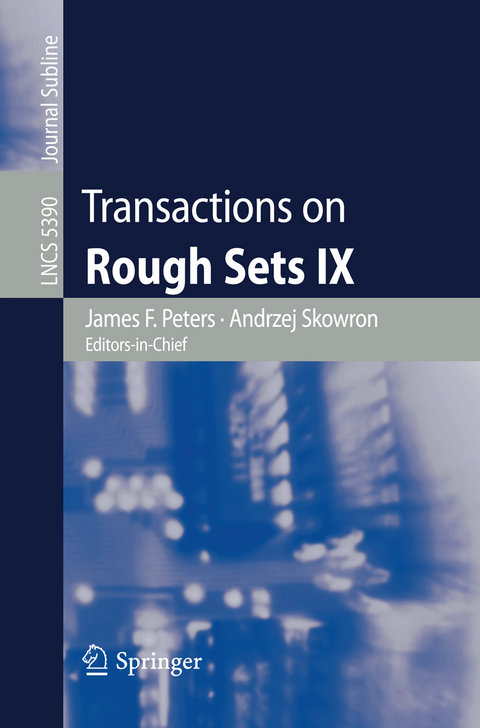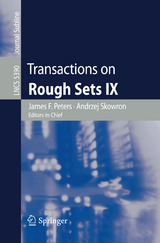Transactions on Rough Sets IX
Springer Berlin (Verlag)
978-3-540-89875-7 (ISBN)
The LNCS journal Transactions on Rough Sets is devoted to the entire spectrum of rough sets related issues, from logical and mathematical foundations, through all aspects of rough set theory and its applications, such as data mining, knowledge discovery, and intelligent information processing, to relations between rough sets and other approaches to uncertainty, vagueness, and incompleteness, such as fuzzy sets and theory of evidence.
This book, which constitutes the ninth volume of the Transactions on Rough Sets series, providing evidence of the continuing growth of a number of research streams. It includes articles that are extensions of papers included in the first conference on Rough Sets and Intelligent Systems Paradigms.
The 26 papers presented in this volume introduce a number of new advances in the foundations and applications of artificial intelligence, engineering, image processing, logic, mathematics, medicine, music, and science.
Vagueness and Roughness.- Modified Indiscernibility Relation in the Theory of Rough Sets with Real-Valued Attributes: Application to Recognition of Fraunhofer Diffraction Patterns.- On Certain Rough Inclusion Functions.- Automatic Rhythm Retrieval from Musical Files.- FUN: Fast Discovery of Minimal Sets of Attributes Functionally Determining a Decision Attribute.- Information Granulation: A Medical Case Study.- Maximum Class Separability for Rough-Fuzzy C-Means Based Brain MR Image Segmentation.- Approximation Schemes in Logic and Artificial Intelligence.- Decision Rule Based Data Models Using NetTRS System Overview.- A Rough Set Based Approach for ECG Classification.- Universal Problem of Attribute Reduction.- Extracting Relevant Information about Reduct Sets from Data Tables.- Context Algebras, Context Frames, and Their Discrete Duality.- A Study in Granular Computing: On Classifiers Induced from Granular Reflections of Data.- On Classifying Mappings Induced by Granular Structures.- The Neurophysiological Bases of Cognitive Computation Using Rough Set Theory.- Diagnostic Feature Analysis of a Dobutamine Stress Echocardiography Dataset Using Rough Sets.- Rules and Apriori Algorithm in Non-deterministic Information Systems.- On Extension of Dependency and Consistency Degrees of Two Knowledges Represented by Covering.- A New Approach to Distributed Algorithms for Reduct Calculation.- From Information System to Decision Support System.- Debellor: A Data Mining Platform with Stream Architecture.- Category-Based Inductive Reasoning: Rough Set Theoretic Approach.- Probabilistic Dependencies in Linear Hierarchies of Decision Tables.- Automatic Singing Voice Recognition Employing Neural Networks and Rough Sets.- Hierarchical Classifiers for Complex Spatio-temporal Concepts.
From the reviews: "Pawlak originally developed rough sets to be used in the same situations as Zadeh's better-known fuzzy sets ... . Although they are less popular than fuzzy sets, they do have a devoted following and are proven to be a good tool when properly applied. ... the quality and significance of the contributions vary considerably. ... the book emphasizes that rough set theory is a viable tool in artificial intelligence and other areas of data handling ... which makes it worth keeping in one's mental toolbox." (Jonathan Golan, ACM Computing Reviews, December, 2009)
From the reviews:
“Pawlak originally developed rough sets to be used in the same situations as Zadeh’s better-known fuzzy sets … . Although they are less popular than fuzzy sets, they do have a devoted following and are proven to be a good tool when properly applied. … the quality and significance of the contributions vary considerably. … the book emphasizes that rough set theory is a viable tool in artificial intelligence and other areas of data handling … which makes it worth keeping in one’s mental toolbox.” (Jonathan Golan, ACM Computing Reviews, December, 2009)
| Erscheint lt. Verlag | 18.12.2008 |
|---|---|
| Reihe/Serie | Lecture Notes in Computer Science | Transactions on Rough Sets |
| Mitarbeit |
Chef-Herausgeber: James F. Peters, Andrzej Skowron |
| Zusatzinfo | X, 751 p. |
| Verlagsort | Berlin |
| Sprache | englisch |
| Maße | 155 x 235 mm |
| Gewicht | 1151 g |
| Themenwelt | Informatik ► Datenbanken ► Data Warehouse / Data Mining |
| Informatik ► Theorie / Studium ► Künstliche Intelligenz / Robotik | |
| Schlagworte | action • Artificial Intelligence • cognitive computation • Data Mining • Data Models • Echocardiography • extension • fraunhofer diffraction patterns • Hardcover, Softcover / Informatik, EDV/Informatik • HC/Informatik, EDV/Informatik • Image Processing • Image Segmentation • indiscernibility • Knowledge • Knowledge Discovery • rhythm retrieval • roughness • vagueness • Voice Recognition |
| ISBN-10 | 3-540-89875-1 / 3540898751 |
| ISBN-13 | 978-3-540-89875-7 / 9783540898757 |
| Zustand | Neuware |
| Haben Sie eine Frage zum Produkt? |
aus dem Bereich




